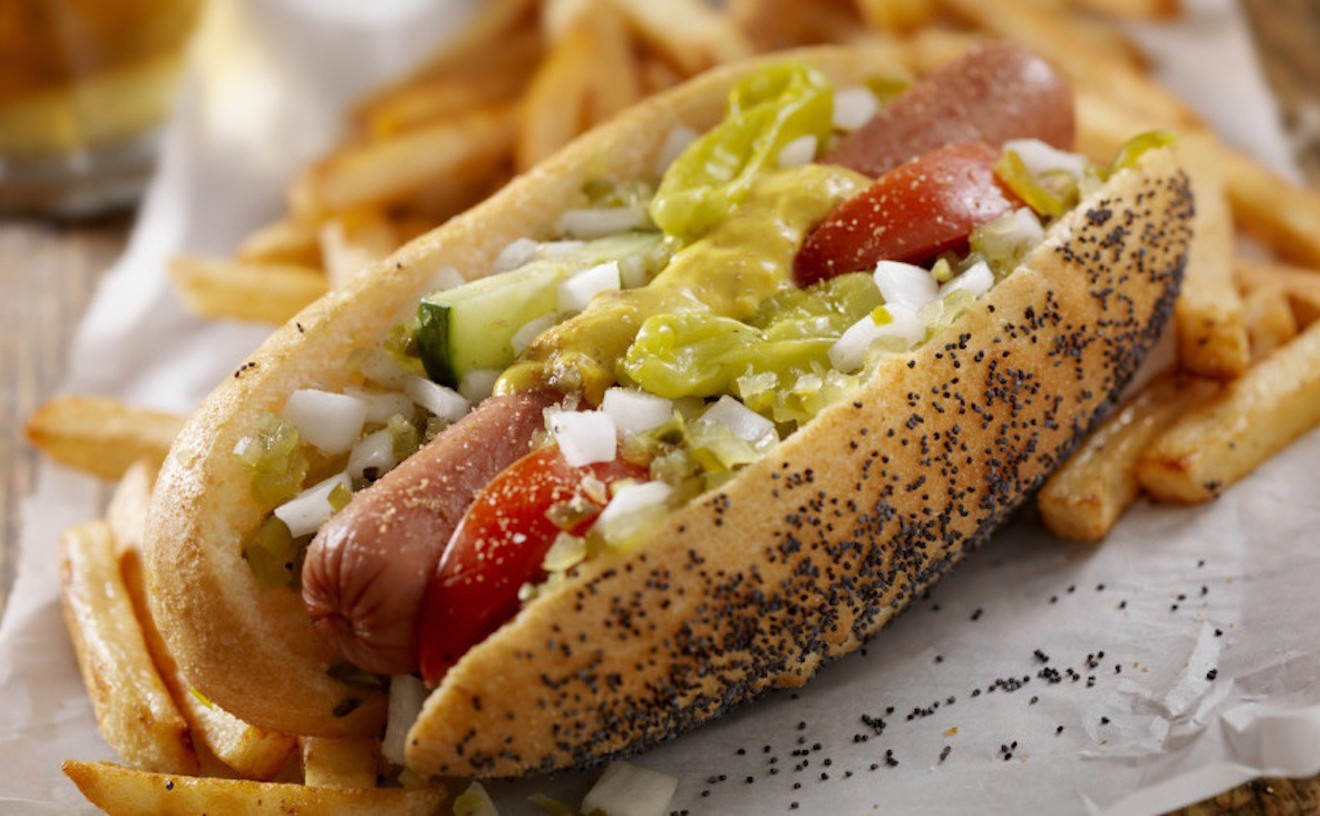Best Restaurant in North Broward
Romantico Ristorante
When Michael di Bella took over Romantico from his mentor, Tonino Tizzano, a few years ago, he didn't hire an interior designer from Miami to hang glittery curtains and space-age uplighting or take on a bevy of PR ladies to spin his "concept" or set up a website with thumping house music and graphic close-ups of dewy basil leaves; he didn't even retrofit his kitchen with subzero coolers. He just went merrily along doing what Tizzano had taught him to do: a simple and silky fettuccini mixed in a parmesan wheel; veal Marsala textured like suede; pristinely fresh poached snapper with olives and tomatoes. And because he hadn't installed those subzero coolers and had so little storage space, di Bella had to keep running out every day to buy each night's ingredients -- which meant, by default, that he was always picking out the freshest fish and the prettiest vegetables. And then too, he'd kept in touch with Tizzano, who'd gone back to Italy (Tizzano was always sending him new ideas, so the menu at Romantico stayed as fresh as the fish). At length, this put him in a place he'd probably never expected to be, as chef-owner of the best restaurant in North Lauderdale. But to look at this tiny place with its handful of tables and to judge from the warm, friendly, and unpretentious way these lovely dishes are served -- from the Sicilian caponata right down to the blissful furls of cannoli -- you'd almost think the idea of di Bella's culinary superiority had never entered his mind.
Best French Fries
Hot Dog Heaven

Courtesy of Hot Dog Heaven
The world is aflutter with waffle fries, crinkle-cut fries, sweet potato fries, and parmesan truffle fries. But sometimes a fry is just a fry... and it's all you need. At Hot Dog Heaven, you get your straight-cut fries placed lovingly on a sheet of tissue paper in an old-fashioned red-and-white checkered cardboard basket. It's comforting to know that, if you want, the attentive staff will ladle on a hefty spoonful of cheese and/or chili. The only downfall: You might have to wait in line for a minute, since the little roadside pit stop is jammed, even at, say, 3:30 on a Tuesday afternoon.
- 101 E. Sunrise Blvd., Fort Lauderdale, 33304 Map
- 954-523-7100
- www.hotdogheavenfl.com/
Best Restaurant in Palm Beach
Saporissimo
If you are not happy, they are not happy. Signor and Signora Monegatti, originally from the island of Elba, serve a mind-boggling menu of Tuscan classics -- rabbit soaked in wine and chocolate, venison osso buco, cuttlefish with pasta in black ink, parpardelle with wild-boar sauce, quails cooked in a casserole, wild duck, fish so fresh it's practically still flopping -- and just about anything else your romantic heart desires. Got a special request? Just call ahead. They want you to eat! Because to eat well is to live well, eh? With no more than a couple of dark-eyed Roman boys for help, the Monegattis turn their shabby-chic couple of rooms in an old Boca house into a place customers never, ever want to leave -- and then dream of coming back to forever. From Signor Monegatti's handshake of greeting to his recitation of the night's specials in charmingly broken English through the pasta courses and the Roman boys circulating with fluffy bowls of freshly grated Parmesan through the second piatti of superlative veal Marsala and elk chop drenched in truffle sauce, right up to the fine old Tuscan desserts and the wobbly cart laden with afterdinner liqueurs, you're revered, jollied, treated with an unforgettable, hearty bonhomie. It's the gustatory equivalent of dining inside a hearty Tuscan bear hug.
- 366 E. Palmetto Park Rd., Boca Raton, 33432 Map
- 561-750-2333
Best Steak House
Gotham City
Steak houses are like people. Well, not really. But sometimes like our human kin, some are unpretentious old money, solid as a duchess in a pair of Wellies. Others haven't given up the checkered tablecloths and celebrity photos after 60 years of business, but the cuts are still prime and dry-aged -- the Andy Rooneys of the steak world. And then there are those shiny, vacant newcomers, interchangeable as Hollywood starlets. Occasionally, a true palace of meat comes along, a place of glamorous mystery and first-quality beef, and when you find one, it rules your heart and invades your dreams. Such a thing is Gotham, as fantastic a place as the mythic city it was named for, shimmering with dark woods and amber lamps, with sheer platinum curtains and walls of candlelight. Gotham bakes golden flatbreads in its wood-burning oven and sends out "silver pot" black Canadian mussels in wine and saffron, wooing the appetite with Dry Sack lobster bisque and chilled Maine lobster cocktails. But all this is foreplay for the main event: dry-aged meats imported from Chicago and cooked over hardwood coals -- center-cut fillet, New York strip, chopped steak with caramelized onions, and that studliest of steaks, the cowboy bone-in rib eye. You'd have to travel many a mile, pardner, to find a rival for your carnivorous affections.
Best Sticky Sweets
Nirala Sweets BBQ

For out-of-the-ordinary desserts, it's hard to beat the creations at Nirala, the first American outpost of an Indo-Pak sweets maker with locations in Pakistan and the Middle East. Indian sweets, as they're commonly called, come in spirals, balls, and dense fudge-like squares. From simple orbs of lightly sweetened cheese curds to halwas scented with carrot, cardamom, and saffron, everything is freshly made on the premises. For the uninitiated, proprietor Muhammad Shabbir and the staff offer enthusiastic guidance and maybe a little taste to help you along. Past the sweetshop counter is a dining room offering Pakistani food, from kebabs to fish curries, and a weekend breakfast of halwa puri, flatbread served with spiced chickpeas and a sweet semolina paste.
- 8913 W. Oakland Park Blvd., Sunrise, 33351 Map
- 954-578-9060
- www.niralasweethouse.com
Best Argentine Restaurant
Che, Pibe

If the authentic food and Spanish-speaking staff and clientele aren't enough to convince you that Che, Pibe offers an authentic Argentine experience, then simply take a look around this charming Miramar restaurant. In one corner, you'll find the local newspapers from Buenos Aires. In the other corner, the television broadcasts fœtbol live from stadiums throughout Latin America. And for Argentines seeking a taste of home or gringos hoping to broaden the palette, Che, Pibe -- which translates loosely to "Hey, Man" -- is the place to come. Located in a strip mall in western Miramar, Che, Pibe takes seriously the art of the Argentine grill and with prices that will please even the most budget-conscious diners. House specials, including the delicious Milanesa Napolitana de Carne and homemade lasagna, range from just $9.99 to $13.99. As most world travelers know, Argentines are known for their steaks -- and here, Che, Pibe doesn't disappoint. Grilled dinner items include "The Argentine Grill," a collection of grilled meats for one ($14.99) or two people ($29.50); the "Top Sirloin" ($12.99); and "Center Cut Pork" ($11.99). Finish off the meal with "Flan With Caramel" ($4.50) or "Sweet Potato With Cheese" ($4.50) and you'll be hard-pressed to find a finer Argentine experience this side of the equator.
- 11040 Pembroke Rd., Miramar, 33025 Map
- 954-433-7224
- chepiberestaurant.com/
Best Milkshake
Doc's All American
The 1950s -- a time when most 12-year-olds were virgins, rock music was as wholesome as Wonder Bread, and the frothy drinks Americans sucked down were not lattes or frappucinos (BlackBerry flavored to match their PDAs) but milkshakes. It's hard to imagine such a time unless you were there. Doc's All American remembers. It was there, serving milkshakes before most of its current customers were even born. That fact alone should answer any doubts about the quality of its shakes. The only question that should remain is which flavor to choose. But first, is it a soft-serve shake from the fountain or one made from hand-dipped ice cream you crave? The former (which costs $2.80 small, $3.45 large) is obviously more limited in its flavorings... but not by much. You're not likely to find pineapple, caramel, and hot fudge at Wendy's anytime soon. But if you're up for the really rich stuff, try a hard shake ($2.95 small, $3.85 large), which comes in flavors like pistachio, cookie dough, toasted coconut, Snickers, and double-fudge brownie. Doc's is open every day. Closing time varies, though it's typically 8:30 p.m. Sunday; 10 to 11 p.m. Monday through Thursday; and 11 p.m. to midnight Friday and Saturday.
- 10 N. Swinton Ave., Delray Beach, 33444 Map
- 561-278-3627
Best Caribbean Restaurant
Sugar Reef

There are places that make a more authentic jerk or bake their fish in banana leaves or boast a grandmother who cooks from secret recipes passed down through generations of African slaves. But for the slow-time pace of a summer evening on a remote island, it's hard to find a restaurant as redolent of Caribbean airs as Sugar Reef, the 12-year-old bistro on the Hollywood Broadwalk that never seems to close its doors against the salt breeze. The fare is mildly spiced French Caribbean, grilled fish with mango salsa, fish stew with coconut milk and green curry, plus flickers of French-Vietnamese, like the seafood and chicken pho, a clear broth laden with shrimp, tender bird, and spices. But Sugar Reef is 100 percent Caribbean in spirit, a place where you can watch the full moon rise over the waves, slip off your shoes under the table, order another bottle of wine, and get to know your neighbors at the next table. No worries.
- 600 N. Surf Rd., Hollywood, 33019 Map
- 954-922-1119
- www.sugarreefgrill.com
Best Chocolate Shop
Galler
When you've been raised on Hershey's kisses, European chocolate may be an acquired taste, like graduating from applesauce to apple martinis. But Belgian candy wizard Jean Geller is betting that the American palate is educable, and his flagship store on Las Olas, opened last Thanksgiving, will test whether Geller can make Floridians googly-eyed over his little mouthfuls of bliss. Geller's products -- handmade chocolates priced at around $1 each -- have the texture of liquid silk and a way of causing very pleasurable hormonal imbalances. These candies are for mature audiences only: The meister sees sugar as an "adulterant" and uses no preservatives. Milk chocolates are 30 percent cocoa, and the darks top out at 85. Instead of gummy sweetness, you'll bite into flavors like gin, curry, mango, kirsch, gingerbread, angelica, pistachios, Arabica, Earl Grey tea, or salted butter caramel -- and it's not out of the question that someone might finish an entire 150-gram tin of chocolate-dipped candied orange peels in a single sitting (a New Times staffer holds this record). Pick your treats by the piece, the pound, or by the box -- an assortment of 24 runs around $25. The effect is rapturous, decadent, addictive.
- 920 E. Las Olas Blvd., Fort Lauderdale, 33301 Map
- 954-523-9690-877-425-5375
- www.gallerusa.com
Best Chinese Restaurant
Hong Kong City BBQ
Hong Kong City isn't the fanciest Chinese restaurant around, though the small, simple room is warm and inviting enough. With the arrival of some more ambitious and diverse Chinese eateries in the area, their Hong Kong and Cantonese cooking is no longer as exotic as it once may have seemed either. But Hong Kong City is like a river, flowing along steadily as the latest trends come and go. It's nigh impossible to have a bad meal here, with impeccably fresh seafood, perfectly cooked vegetables, a light touch with frying, and just-right sauces. You'll go back for the sublime casseroles, the pan-fried noodles, the scallops in black pepper sauce that melt in the mouth, the sautéed greens. And though they have the usual lunch combo specials, dim sum is available daily too.
- 5301 N. State Road 7, Tamarac, 33319 Map
- 954-777-3832
- www.hkcitybbq.com/





